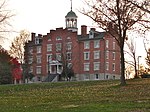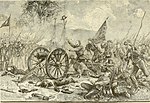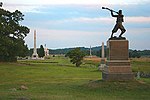The Lutheran Theological Seminary at Gettysburg (Gettysburg Seminary) was a seminary of the Evangelical Lutheran Church in America (ELCA) in Gettysburg, Pennsylvania. It was one of seven ELCA seminaries, one of the three seminaries in the Eastern Cluster of Lutheran Seminaries, and a member institution of the Washington Theological Consortium. It was founded in 1826 under prominent but controversial theologian and professor Samuel Simon Schmucker (1799-1873) for the recently organized General Synod of the Evangelical Lutheran Church in the United States. The seminary was the oldest continuing Lutheran seminary in the United States until it was merged on July 1, 2017, after 189 years of operation, with the nearby and former rival Lutheran Theological Seminary at Philadelphia to form the United Lutheran Seminary. The new institution continues to use both campuses.
The Gettysburg Seminary served the church as a pioneer in theological education creating among Lutheran seminaries the first faculty position in Christian Education in 1926, the first teacher in sociology and psychology in 1942, and the first in stewardship in 1989. Gettysburg continued to add to its trail breaking in the American scene by granting tenure to a female professor, Bertha Paulssen, in 1945, and graduating, in 1965, the first woman to be ordained by an American Lutheran church body, Elizabeth Platz (graduated in 1965 and ordained in 1970). the seminary was also the first Lutheran seminary to admit an African American theological student and seminarian, Daniel Alexander Payne, in 1835, only nine years after its founding.
During the pivotal Battle of Gettysburg in the American Civil War, the seminary, on a ridge northwest of the town, became a focal point of action on the first day of battle, July 1, 1863. The seminary gave its name to the now iconic Seminary Ridge, where the line of battle of the Confederate Army of Northern Virginia was formed for the later actions on the second and third days of the battle. The headquarters of commanding Gen. Robert E. Lee was established in a stone cottage across the northwest Cashtown Road.









